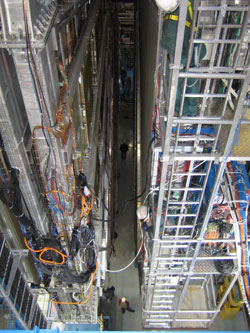
ATLAS e-News
23 February 2011
Big Wheels consolidation work
8 December 2008

GSM phone conference - 12 pairs of eyes on 12 weak points during the move
A joint effort between the ATLAS Technical Coordination and the ATLAS muon system community have made possible to replace the optical fibres in the ‘Big Wheels’. The system is now ready to resist the level of radiation produced when proton collisions will happen in the LHC at full design luminosity. Raphael Vuillermet, the mechanical engineer leading the opening effort, has explained to e-news the bottlenecks of the operation.
The Monitored Drift Tube (MDT) chambers, which are part of the ‘Big wheels’, needed new radiation hard optical fibres. MDT chambers are the main components of two of the eight ‘Big Wheels’, while the remaining six are made of thin-gap chambers (TGC).
The replacement of the optical fibres for more than eighty precision tracking MDT chambers was not initially scheduled for this year, but the sudden stop of the LHC and the decision to open the ATLAS detector to do some repairs, gave the opportunity to run the operation.
“The previous fibres could only resist a small fraction of the radiation dose expected to be integrated during the high luminosity data-taking period,” Raphael explains. So, in order to avoid radiation damage in the muon system, which would stop data-taking in the MDT chambers, the replacement was required.
Getting access to the MDT surface was not easy; the four wheels are inter-connected to each other through cables and gas and cooling liquid pipes, which bring services to the different sectors of the muon system. “As the four wheels are linked by services, in order to separate them, we had to move the wheels carefully and check that there were no cables or pipes broken, which could have lead to dangerous leaks, and irreversible damages,” Raphael explains.
For this, the Technical Coordination group developed a procedure to separate the wheels in a safe way, in which thirteen CERN engineers and technicians were involved. Twelve people were charged with following the wheels’ movement, checking that all the services were kept undamaged during the operation, and Raphael, as operations leader, coordinated everyone through a phone conference –a rather normal communication tool in an office, but an unusual one in a cavern.
“The trickiest part was the communication between all of us,” Raphael says. “In this sort of operations, a phone conference is the best way to make sure that all of us can talk to each other at the same time.”
“The problem was that the environment was very noisy and we could hardly hear each other; but we managed well in the end,” he laughs.
Once the wheels were separated by about 1.3m from each other, the space left in between was so narrow than only a small basket hanged from the crane could bring one operator down in between the wheels to replace the optic fibers on the surface of the MDT chambers.
The replacement work started when the detector was opened after the LHC halt, on October 20 and finished on November 14, taking about four weeks.In the spring of 2009, the same team will repeat the same operation in side A, just before closing the detector ahead of the LHC switch on.

Cristina JimenezATLAS e-News |